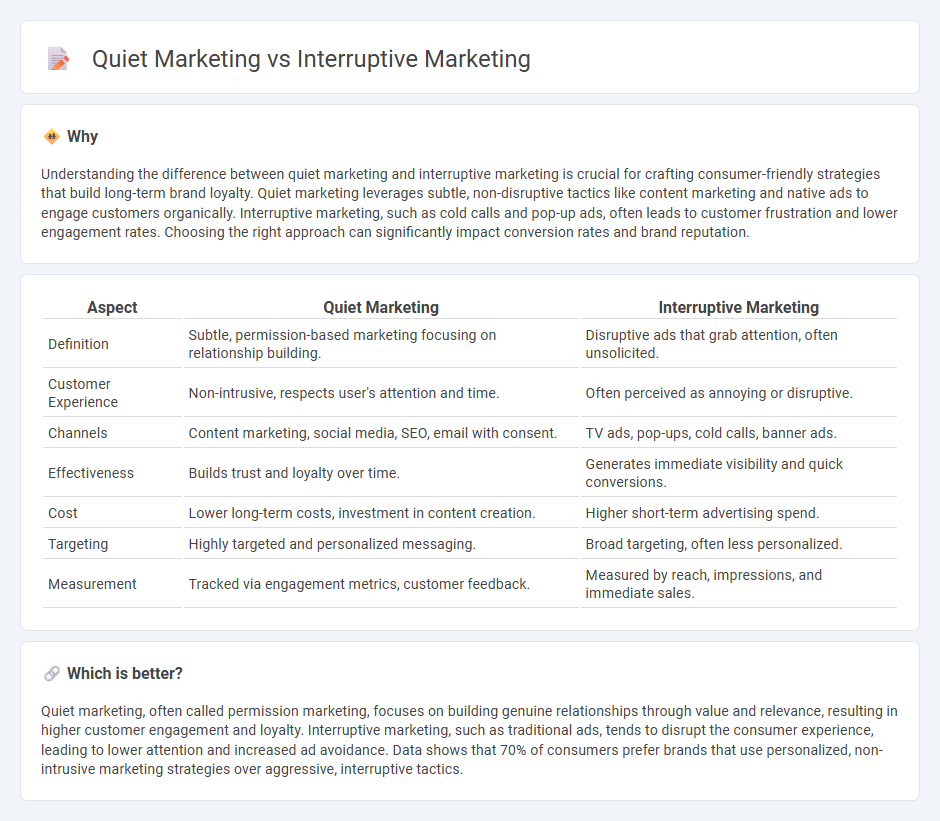
Quiet marketing focuses on subtle, value-driven strategies that engage audiences without overt advertisements, enhancing brand trust and customer loyalty. Interruptive marketing relies on bold, attention-grabbing tactics that disrupt the audience's experience to deliver immediate messages and drive quick responses. Discover how these contrasting approaches shape consumer behavior and business success.
Why it is important
Understanding the difference between quiet marketing and interruptive marketing is crucial for crafting consumer-friendly strategies that build long-term brand loyalty. Quiet marketing leverages subtle, non-disruptive tactics like content marketing and native ads to engage customers organically. Interruptive marketing, such as cold calls and pop-up ads, often leads to customer frustration and lower engagement rates. Choosing the right approach can significantly impact conversion rates and brand reputation.
Comparison Table
| Aspect | Quiet Marketing | Interruptive Marketing |
|---|---|---|
| Definition | Subtle, permission-based marketing focusing on relationship building. | Disruptive ads that grab attention, often unsolicited. |
| Customer Experience | Non-intrusive, respects user's attention and time. | Often perceived as annoying or disruptive. |
| Channels | Content marketing, social media, SEO, email with consent. | TV ads, pop-ups, cold calls, banner ads. |
| Effectiveness | Builds trust and loyalty over time. | Generates immediate visibility and quick conversions. |
| Cost | Lower long-term costs, investment in content creation. | Higher short-term advertising spend. |
| Targeting | Highly targeted and personalized messaging. | Broad targeting, often less personalized. |
| Measurement | Tracked via engagement metrics, customer feedback. | Measured by reach, impressions, and immediate sales. |
Which is better?
Quiet marketing, often called permission marketing, focuses on building genuine relationships through value and relevance, resulting in higher customer engagement and loyalty. Interruptive marketing, such as traditional ads, tends to disrupt the consumer experience, leading to lower attention and increased ad avoidance. Data shows that 70% of consumers prefer brands that use personalized, non-intrusive marketing strategies over aggressive, interruptive tactics.
Connection
Quiet marketing and interruptive marketing are connected through their contrasting approaches to consumer engagement; quiet marketing relies on subtle, non-disruptive tactics like content marketing and influencer partnerships, whereas interruptive marketing uses direct, attention-grabbing methods such as pop-ups and cold calls. Both strategies aim to increase brand visibility and conversion rates but differ in audience receptivity and effectiveness depending on the industry and target demographic. Understanding this connection helps marketers balance engagement techniques to optimize customer experience and campaign performance.
Key Terms
Attention-grabbing
Interruptive marketing captures audience attention through bold, often intrusive tactics such as pop-ups, loud ads, and aggressive promotions that break the consumer's flow. Quiet marketing relies on subtle, insightful content like storytelling, personalized messages, and valuable information to naturally engage consumers without overwhelming them. Explore the strategies and benefits behind both approaches to determine the best fit for your brand's attention-grabbing goals.
Permission-based
Interruptive marketing disrupts the consumer experience by pushing unsolicited ads, often leading to lower engagement and increased resistance. In contrast, quiet marketing emphasizes permission-based strategies, such as email opt-ins and content marketing, fostering trust and higher conversion rates. Explore how permission-based quiet marketing can build long-term customer relationships and enhance brand loyalty.
Intrusiveness
Interruptive marketing relies on aggressive tactics such as pop-up ads, cold calls, and unsolicited emails that disrupt the consumer's experience, often leading to negative brand perception and lower engagement rates. Quiet marketing emphasizes subtle, value-driven strategies like content marketing, native ads, and influencer partnerships, fostering trust and long-term customer relationships without overtly disturbing the audience. Explore further to understand how prioritizing intrusiveness impacts your brand's effectiveness and customer loyalty.
Source and External Links
Interruption marketing - It is a marketing strategy where promotional messages interrupt the audience's experience, often through ads like TV/radio spots, cold calling, or social media promotions; it aims for quick results and measurable impact but can be seen as annoying.
What Is Interruption Marketing? - This strategy interrupts the target audience with unsolicited promotional messages, relying on intrusion and keeping attention, often delivering fast and observable results but degrading user experience.
Discover the Power of Interruption Marketing - Interruption marketing interrupts consumers' routines with promotional content to generate immediate engagement and customer response, increasing brand visibility and prompting urgent actions like calls or website visits.
 dowidth.com
dowidth.com